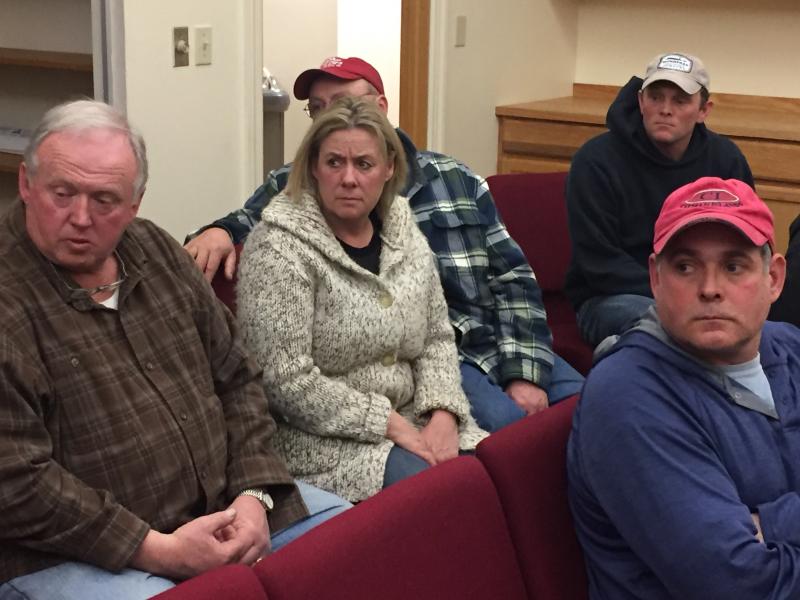A New Harbor fisherman put his and about 50 others’ opposition to a proposed wind power pilot program in Boothbay pretty succinctly during the Feb. 28 selectmen’s meeting: “We have nothing to gain and everything to lose.” Michael Dawson was one of four Midcoast fishermen who voiced their opposition to a University of Maine-led consortium of 19 other private and public partners interested in developing an experimental off-shore wind farm near Monhegan Island.
Maine Aqua Ventus is the consortium which includes UMaine’s Advanced Structures & Composites Center and Cianbro Corporation. The pilot program would connect two turbines off Monhegan Island producing six megawatts of electricity to a nearby location. Bristol, Saint George and Boothbay are among 11 locations Maine Aqua Ventus has reviewed.
But regardless of location, local fishermen are concerned the pilot project’s turbines and attached cable to the mainland will disrupt the local fishing industry. Over several months, MAV has held a series of meetings seeking fishermen’s input. The firm hired Power Engineers of Freeport to facilitate communication with local fishermen. In turn, Power Engineers employed Boothbay fisherman Larry Knapp, who previously served as a liaison during Statoil ASA’s attempt at developing a nearby wind farm.
On Jan. 26, MAV presented an overview of its proposal to the board. Selectmen wanted more information and invited the developer and local fishermen for a discussion last week. Prior to the meeting, MAV was in the process of drafting a series of responses to fishermen’s past questions. Two days after the meeting, the firm posted its responses on its website, maineaquaventus.com
Despite the ongoing dialog, fishermen told selectmen they are wary about the project. They are also skeptical about prognostications it will only minimally impact fishing. Another concern is the pilot project will develop into a full-scale wind farm in the Gulf of Maine.
“My concern is we will end up with wind farms from Rockland to Portland, and they will tell lobstermen, ‘You’re out of here!’” said Boothbay Harbor fisherman Andy Hawke.
Dr. Habib Dagher, P.E. is the founding executive director of the Advanced Structures & Composites Center, a National Science Foundation-funded research center. He is the project leader. In previous meetings, Dagher presented a draft fishing industry memorandum of understanding stating MAV would not license its floating wind turbine technology without a proper sitting review by the Maine fishing industry, Maine Lobsterman’s Association and Maine Coast Fishermen’s Association.
But fishermen didn’t take stock in any promises. They complained about how the project has morphed several times since its introduction and believe a memorandum wouldn’t prevent future changes.
“The way it’s written is pretty vague,” Wilson said.
MAV became interested in a Midcoast location in 2016 after the Advanced Structures & Composites Center won a $3.7 million grant for developing an offshore wind farm. The center has searched for a receptive community for its research and development project. But local fishermen’s opposition ended hopes of Bristol or Saint George being a possible site.
“I come into this with an open mind, but the past conversations have just created distrust,” said Eben Wilson, a Bristol fisherman.
MAV invited two UMaine researchers to the selectmen’s meeting to provide analysis of the project’s impact on marine life. Researchers Dr. Richard Wahle and Dr. Robert Steneck specialize in marine ecological studies. Based on worldwide research, the two addressed major concerns about the proposal. One is the transmission cable will interfere with fishing nets. Steneck used a cable connecting Vinalhaven to Rockland as an example. The cable was laid in 2005, and hadn’t produced any major disturbances. The experts also reported research showed no evidence electromagnetic fields from cables posed a threat to marine life.
Dagher reaffirmed his group’s commitment to local fishing. His group sent a draft letter to a Saint George fisherman indicating MAV would involve fishermen regarding the project’s future such as selling research to wind power developers, but the fishermen remained skeptical. They complained about how the project has changed over the years and difficulty communicating with the developer.
A Friendship lobsterman told selectmen the project jeopardizes his livelihood which his family has been involved in for generations. Dustin Delano had recently fished around Monhegan Island. He told selectmen the community is deeply divided over the project. He described the project as bad for Maine and the state’s fishing heritage.
“This is all I know how to do. What’s going to happen if this changes everything,” Delano said. “We are seeing a lot of red flags starting to fly. I don’t want my livelihood being replaced by a 550-foot turbine.”
MAV is seeking selectmen’s approval prior to submitting a planning board application. Selectman Chuck Cunningham told fishermen the board wanted to meet with them before making a decision.
“We haven’t said yes to anything. We are interested in the R&D (research and development) aspect because of the jobs, but we don’t want anybody to get harmed,” he said.
MAV is awaiting results from a soil test of the ocean floor in East Boothbay prior to moving forward with the project’s next phase. The transmission cable would be buried six feet under the ocean floor near Hodgdon Yachts. Researchers are concerned the burying would stir up chemicals accumulated on the ocean floor over two centuries of boat building and negatively impact fishing. If a core sample study shows substantial soil contamination, MAV would seek another location.
A Jan. 18 meeting between local fishermen and MAV at the fire station in Boothbay drew over 50. Selectmen requested a smaller group for the selectmen’s meeting.
According to Town Manager Dan Bryer, MAV isn’t required to seek selectmen’s approval for the project, but the firm is looking for a community receptive to the project.






























